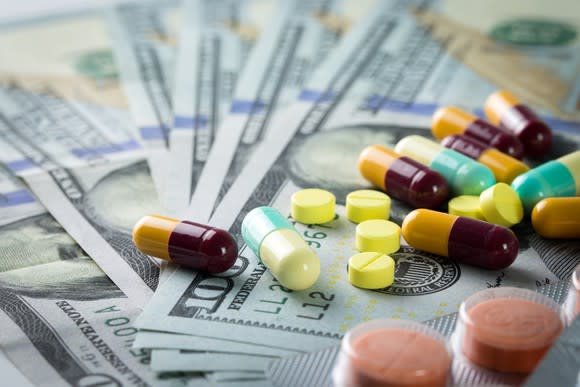Valeant Pharmaceuticals' 4th Quarter Results Show No Turnaround Yet
Investors liked much of what they heard when Valeant Pharmaceuticals (NYSE: VRX) reported its third-quarter 2017 results in November. The drugmaker posted a big profit, although it stemmed from a one-time tax benefit. More important, Valeant took great strides in reducing its debt.
That was then. Valeant announced its fourth-quarter and full-year 2017 results before the market opened on Wednesday. This time, investors weren't as pleased with the company's report. Here are the highlights.

Image source: Getty Images.
Valeant results: The raw numbers
Metric | Q4 2017 | Q4 2016 | Year-Over-Year Change |
|---|---|---|---|
Revenue | $2.16 billion | $2.4 billion | (10%) |
Net income (loss) from continuing operations | $512 million | ($512 million) | N/A |
Diluted earnings (loss) per share | $1.45 | ($1.47) | N/A |
Data Source: Valeant.
What happened with Valeant this quarter?
Valeant's revenue continued to plunge in the fourth quarter. Much of this decline was to be expected since the company has sold off several of its businesses and product lines, including Dendreon, iNova Pharmaceuticals, Obagi Medical Products, and skin care products CeraVe, AcneFree, and AMBI. In addition, Valeant lost exclusivity for quite a few products. Generic competition for these products took a bite out of revenue.
These factors weighed on Valeant's branded Rx segment especially. Fourth-quarter sales for the segment plunged 19% year over year to $602 million. There was a little good news for branded Rx, though, with sales for the Salix business rising 3% higher than the prior-year period.
Fourth-quarter sales for Valeant's U.S. diversified products segment sank 16% year over year to $335 million. Loss of exclusivity for a basket of products contributed primarily to this decline.
In the third quarter, Valeant received a boost from its largest business, the Bausch + Lomb/international segment. That didn't happen in the fourth quarter. Sales for the segment fell 3% year over year to $1.23 billion, largely due to divestitures. Excluding the impact of these divestitures and currency fluctuations, however, fourth-quarter sales for the segment grew organically by around 4% year over year.
The company's bottom line in the fourth quarter received a boost from a one-time tax benefit of $1.3 billion. For full-year 2017, Valeant posted a one-time tax benefit of $4.1 billion.
What management had to say
Valeant chairman and CEO Joe Papa said, "2017 was a year of strong progress for Valeant as we delivered organic growth across nearly 75 percent of the Company while significantly reducing our debt and investing in our Bausch + Lomb, Salix and Ortho Dermatologics businesses."
Papa added:
Since the end of the first quarter of 2016, we've reduced our total debt by more than 20 percent, and we will continue to address our debt, as well as reduce expenses. Additionally, we're committed to growth through strategic investment in our core businesses, key products and late-stage pipeline. Altogether, these will get us to the final phase of our strategic plan – the transformation of Valeant.
Looking forward
Valeant provided full-year 2018 revenue guidance of $8.1 billion to $8.3 billion. The midpoint of that range represents a 6% year-over-year decline. The company also expects full-year adjusted EBITDA between $3.05 and $3.2 billion, a 14% drop from 2017 at the midpoint of the range.
Joe Papa has stated in the past that 2016 was a year of stabilization for Valeant, with the drugmaker undergoing a turnaround in 2017 and 2018. Valeant's actual performance from last year and its guidance for this year, however, seem to show that the company is still more in stabilization mode.
There are some developments this year that could help Valeant move into a true turnaround, though. Investors will want to watch if psoriasis drug Siliq picks up momentum. Valeant hopes to win FDA approvals for two topical treatments for plaque psoriasis this year -- Duobrii and Jemdel. The company also expects an FDA decision on acne treatment Altreno by late August.
Valeant reduced its debt by more than $4.4 billion in 2017. Expect the drugmaker to continue divesting some non-core assets to lower the debt even more. However, the key for Valeant's success has to be product sales growth. The next few quarters will show whether or not the company will be able to deliver.
More From The Motley Fool
Keith Speights has no position in any of the stocks mentioned. The Motley Fool owns shares of and recommends Valeant Pharmaceuticals. The Motley Fool has a disclosure policy.

 Yahoo Finance
Yahoo Finance 